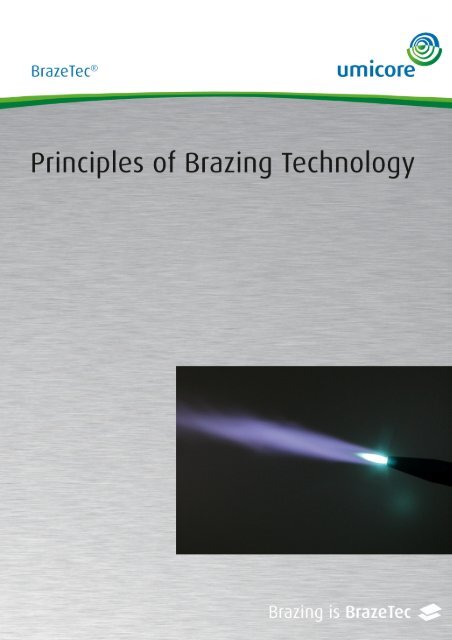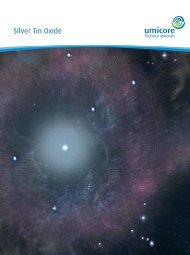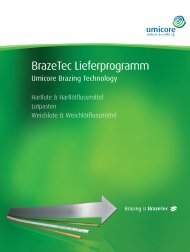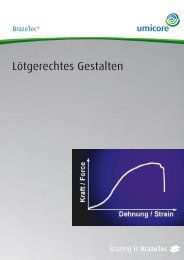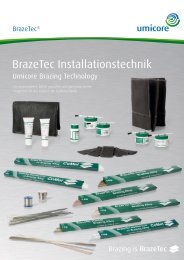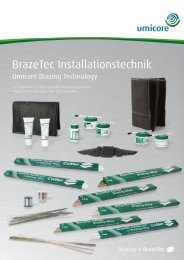Principles of brazing technology - technicalmaterials.umicore.com
Principles of brazing technology - technicalmaterials.umicore.com
Principles of brazing technology - technicalmaterials.umicore.com
Create successful ePaper yourself
Turn your PDF publications into a flip-book with our unique Google optimized e-Paper software.
<strong>Principles</strong> <strong>of</strong> <strong>brazing</strong> <strong>technology</strong><br />
Brazing is a thermal process for securely joining and<br />
coating materials, whereby a liquid phase is<br />
produced by melting a <strong>brazing</strong> alloy (fusion-<strong>brazing</strong>)<br />
or by diffusion at the interfaces (diffusion-<strong>brazing</strong>).<br />
The solidus temperature <strong>of</strong> the base material is not<br />
reached (DIN 8505, Part 1).<br />
1. Standards and regulations for <strong>brazing</strong><br />
1.1 Re<strong>com</strong>mendations for <strong>brazing</strong><br />
- Technical information sheets<br />
- Standards<br />
Technical information sheets: Re<strong>com</strong>mended<br />
These are prepared by experts in work groups and<br />
the information corresponds to the respective state <strong>of</strong><br />
<strong>technology</strong>. It is re<strong>com</strong>mended that the technical<br />
information sheets be heeded as they are also<br />
viewed as the respective state <strong>of</strong> the <strong>technology</strong> from<br />
a legal point <strong>of</strong> view.<br />
Examples:<br />
- DVS-Guideline 1183: DVS-course „Brazing<br />
copper materials“<br />
- VdTÜV – Technical Information Sheet 1160:<br />
„Evaluation <strong>of</strong> processes for manufacturing<br />
brazed joints and high temperature brazed<br />
joints“<br />
- DVGW – Work Sheet GW2<br />
Standards: Compulsory<br />
Any deviation from the standard must be specifically<br />
agreed between the client and contractor. There are<br />
currently many national (DIN), european (EN) and<br />
international (ISO) standards. The existing German<br />
standards are being superseded by European<br />
standards. Referral is made in particular here to DIN<br />
EN 1044 „Brazing – <strong>com</strong>position <strong>of</strong> <strong>brazing</strong><br />
alloys“ which replaces DIN 8513 Parts 1-5 and to<br />
DIN EN 1045 „Brazing – fluxes for <strong>brazing</strong>“ which<br />
replaces DIN 8511-1. Both these standards<br />
categorise the respective materials. There are also<br />
standards in existence which cover the terms used in<br />
<strong>brazing</strong>, constructional aspects, testing <strong>of</strong> brazed<br />
joints, inspecting brazed joints, etc. which can be<br />
obtained via Beuth-Verlag (Berlin) or DVS-Verlag<br />
(Düsseldorf).<br />
1.2 Regulations for work safety and accident<br />
prevention, e.g.:<br />
- Accident prevention regulations, section 15:<br />
„Welding and related techniques “ d.BG;<br />
- VDI 2046 „Safety guidelines for operating<br />
industrial furnaces with inert gas and reactive<br />
atmospheres“<br />
2. Wetting process and capillary forces<br />
2.1 Distinction between welding and <strong>brazing</strong><br />
In welding not only is the added alloy material melted<br />
but the base material is also partially melted.<br />
In <strong>brazing</strong> only the added <strong>brazing</strong> alloy melts. The<br />
base material is wetted in its solid state by the liquid<br />
<strong>brazing</strong> alloy.<br />
Fusion welding Brazing<br />
Usually similar materials Virtually any desired material<br />
<strong>com</strong>binations<br />
Virtually identical melting Brazing alloy melts at<br />
temperatures for the base lower temperature<br />
material and alloy than the base material<br />
2.2 Wetting<br />
A prerequisite for <strong>brazing</strong> is the wetting <strong>of</strong> the base<br />
material by the <strong>brazing</strong> alloy. Three important<br />
conditions must be fulfilled for this to happen:<br />
• the <strong>brazing</strong> surfaces and the <strong>brazing</strong> alloy must<br />
be „bare metal“,<br />
• the <strong>brazing</strong> surfaces and the <strong>brazing</strong> alloy must<br />
have at least reached the working temperature,<br />
• at least one <strong>com</strong>ponent <strong>of</strong> the <strong>brazing</strong> alloy must<br />
readily form an alloy with the base material.<br />
Umicore AG & Co. KG - BrazeTec, Rodenbacher Chaussee 4, D-63457 Hanau-Wolfgang<br />
Telefon: +49 (0) 6181-59-03 Telefax: +49 (0) 6181-59-3107 Email: info@BrazeTec.de Internet: www.BrazeTec.de
<strong>Principles</strong> <strong>of</strong> <strong>brazing</strong> <strong>technology</strong><br />
Base material<br />
- Visible oxide layers (rust and scale), fat layers<br />
and layers <strong>of</strong> dirt must be removed before<br />
carrying out <strong>brazing</strong> work. Thin oxide layers (e.g.<br />
tarnishing) may remain on the workpieces if<br />
<strong>brazing</strong> is carried out using a flux.<br />
- The working temperature is the lowest surface<br />
temperature <strong>of</strong> a workpiece at the <strong>brazing</strong> joint at<br />
which the <strong>brazing</strong> alloy can wet, spread and bond<br />
with the base material. This temperature is always<br />
higher than the solidus temperature <strong>of</strong> the <strong>brazing</strong><br />
alloy. It can be above, below or the same as its<br />
liquidus temperature.<br />
- The wetting process involves surface alloying<br />
between the <strong>brazing</strong> alloy and the base material.<br />
Next to the wetting zone there is a diffusion zone<br />
which is very small for <strong>brazing</strong> work and cannot<br />
be detected by metallographic means. In order to<br />
attain optimum strength, the <strong>brazing</strong> alloy must be<br />
liquid for at least 8 to 10 seconds to give an<br />
adequately deep diffusion zone.<br />
There is greater interaction between the <strong>brazing</strong> alloy<br />
and base material when carrying out high<br />
temperature <strong>brazing</strong> (flux-free <strong>brazing</strong> at<br />
temperatures above 900°C in a controlled<br />
atmosphere).<br />
2.3 Joint-<strong>brazing</strong> and gap-<strong>brazing</strong><br />
Joint-<strong>brazing</strong> is a <strong>brazing</strong> technique similar to gasfusion<br />
welding from a joint preparation and working<br />
method point <strong>of</strong> view. It is virtually always carried out<br />
manually. The working temperature <strong>of</strong> the <strong>brazing</strong><br />
alloy must not be exceeded when joint-<strong>brazing</strong>.<br />
1 to 1.5 mm<br />
The most important area <strong>of</strong> application <strong>of</strong> joint<strong>brazing</strong><br />
is for <strong>brazing</strong> galvanised steel pipes.<br />
The workpieces are prepared for gap-<strong>brazing</strong> such<br />
that the <strong>brazing</strong> joints are narrow capillary gaps.<br />
They are heated up to <strong>brazing</strong> temperature uniformly<br />
over the whole length <strong>of</strong> the gap. The liquid <strong>brazing</strong><br />
alloy is forced into the gap by „capillary filling<br />
pressure“. This technique is easy to mechanise. The<br />
majority <strong>of</strong> <strong>brazing</strong> work is carried out by the gap<strong>brazing</strong><br />
technique.<br />
The surface forces are additive in the narrow<br />
capillary gaps (size <strong>of</strong> the order <strong>of</strong> 0.1 mm), so that<br />
the <strong>brazing</strong> alloy is preferentially drawn into the<br />
narrow gap. If <strong>brazing</strong> is being carried out with a flux<br />
in a gas atmosphere, the <strong>brazing</strong> alloy which<br />
penetrates into the <strong>brazing</strong> gap must be able to push<br />
the flux out <strong>of</strong> the gap.<br />
In gap-<strong>brazing</strong>, the working temperature <strong>of</strong> the<br />
<strong>brazing</strong> alloy may be exceeded – by in general 20 to<br />
50°C.<br />
Umicore AG & Co. KG - BrazeTec, Rodenbacher Chaussee 4, D-63457 Hanau-Wolfgang<br />
Telefon: +49 (0) 6181-59-03 Telefax: +49 (0) 6181-59-3107 Email: info@BrazeTec.de Internet: www.BrazeTec.de
<strong>Principles</strong> <strong>of</strong> <strong>brazing</strong> <strong>technology</strong><br />
Start <strong>of</strong> the wetting Intermediate state<br />
II = Workpiece 1<br />
II = Workpiece 2<br />
Both bare metal, and<br />
heated to working<br />
temperature<br />
• Liquid <strong>brazing</strong> alloy<br />
Capillary filling pressure<br />
Final state<br />
The <strong>brazing</strong> alloy is pressed into the gap by capillary<br />
forces. The narrower the <strong>brazing</strong> gap, the higher the<br />
capillary filling pressure.<br />
For a 0.1 mm parallel gap, the capillary filling<br />
pressure reaches ca. 100 mbar, corresponding to<br />
about 0.1 Atm. This in turn corresponds to about a 1<br />
m column <strong>of</strong> water ( ρ = 1); assuming ρ = 10 g/cm 3<br />
(the density <strong>of</strong> a <strong>brazing</strong> alloy), the capillary height<br />
for low melting point <strong>brazing</strong> alloys in a 0.1 mm wide<br />
gap can be calculated to be ca. 10 cm. This agrees<br />
reasonably well with experiences in practice.<br />
Gap too narrow<br />
Correct gap width<br />
(only applies for<br />
<strong>brazing</strong> with flux)<br />
Permissible gap width for manual <strong>brazing</strong><br />
Gap too wide<br />
Different gap cross-sections give different filling<br />
pressures. An open fillet has a six times higher<br />
capillary filling pressure than a parallel flat gap.<br />
3. Brazing alloy and flux groups<br />
3.1 Brazing alloys<br />
According to DIN 8505, alloys with a liquidus<br />
temperature below 450°C are solders and those with<br />
a liquidus temperature above 450°C are <strong>brazing</strong><br />
alloys.<br />
The upper and lower <strong>brazing</strong> temperature limits are<br />
determined by the following:<br />
lower limit<br />
- the working temperature<br />
upper limit<br />
- the flux (be<strong>com</strong>es saturated with oxides at<br />
too high temperatures), or<br />
- the <strong>brazing</strong> alloy (individual <strong>com</strong>ponents <strong>of</strong><br />
the alloy can evaporate), or<br />
- the economics <strong>of</strong> the process (unnecessarily<br />
high temperatures cost unnecessary time<br />
and energy), or<br />
- the base material (structural transformation;<br />
strength loss).<br />
Umicore AG & Co. KG - BrazeTec, Rodenbacher Chaussee 4, D-63457 Hanau-Wolfgang<br />
Telefon: +49 (0) 6181-59-03 Telefax: +49 (0) 6181-59-3107 Email: info@BrazeTec.de Internet: www.BrazeTec.de
<strong>Principles</strong> <strong>of</strong> <strong>brazing</strong> <strong>technology</strong><br />
3.2 Fluxes<br />
Fluxes are solvents for metal oxides. They have an<br />
effective temperature range within which they are<br />
able to dissolve metal oxides. The solvating capacity<br />
<strong>of</strong> the flux is limited. About 5% <strong>of</strong> the weight <strong>of</strong> flux in<br />
metal oxides can be dissolved. If oxides are present<br />
in greater amounts, the flux saturates and it loses its<br />
functionality.<br />
Atmospheric<br />
oxygene Flux Oxide<br />
More than 5 min.<br />
The hygroscopic flux residues must be removed by<br />
scouring in water or by pickling in pickling baths<br />
suitable for the base materials. Ultrasound aids the<br />
removal <strong>of</strong> these flux residues.<br />
The non-hygroscopic flux residues do not have to be<br />
removed for fear <strong>of</strong> corrosion. If they need to be<br />
removed for other reasons (e.g. to paint the<br />
<strong>com</strong>ponents), they are usually removed by<br />
mechanical means (e.g. sand-blasting).<br />
Too little Sufficient<br />
Oxide film remains Oxide film is<br />
dissolved<br />
The solvating capacity <strong>of</strong> modern <strong>brazing</strong> fluxes for<br />
use at low temperatures (i.e. between 600 and<br />
800°C) for <strong>com</strong>mon heavy metal oxides is between 1<br />
and 5%, meaning that it is limited. That means that<br />
relative to the oxide which is present a relatively<br />
large amount <strong>of</strong> flux must be available, and ultimately<br />
so in the molten state, otherwise sound <strong>brazing</strong> work<br />
is not achieved. Extremely narrow gaps, e.g. less<br />
than 0.02 mm, hence cause problems because there<br />
is an inadequate amount <strong>of</strong> flux in the gap. This<br />
naturally has a big effect on the soundness <strong>of</strong> the<br />
brazed joint.<br />
Wire <strong>of</strong> <strong>brazing</strong> alloy<br />
Umicore AG & Co. KG - BrazeTec, Rodenbacher Chaussee 4, D-63457 Hanau-Wolfgang<br />
Telefon: +49 (0) 6181-59-03 Telefax: +49 (0) 6181-59-3107 Email: info@BrazeTec.de Internet: www.BrazeTec.de<br />
Flux<br />
For surface <strong>brazing</strong>, the high capillary filling pressure<br />
in the open fillets leads to running <strong>of</strong> the <strong>brazing</strong> alloy<br />
on the external sides. The supply <strong>of</strong> <strong>brazing</strong> alloy to<br />
the narrow surface gap is reduced; increased<br />
inclusion <strong>of</strong> flux hence occurs.<br />
Brazing alloy<br />
Flux<br />
Increased flux inclusion can be avoided by inserted<br />
<strong>brazing</strong> alloy sheet.<br />
Gaseous fluxes<br />
Joints (V-seams and fillets) can be brazed using<br />
gaseous fluxes. For <strong>brazing</strong> gaps – especially for<br />
gaps having larger depths and small widths – the use<br />
<strong>of</strong> gaseous fluxes is not re<strong>com</strong>mended because the<br />
flame does not penetrate into the capillary gap.<br />
When using flux pastes, their working life can be<br />
significantly prolonged by the additional use <strong>of</strong><br />
gaseous fluxes.<br />
The effective temperature <strong>of</strong> gaseous fluxes extends<br />
from about 750°C to 1100°C.
<strong>Principles</strong> <strong>of</strong> <strong>brazing</strong> <strong>technology</strong><br />
Brazing with flux-forming <strong>brazing</strong> rods - BrazeTec<br />
Silfos <strong>brazing</strong> alloys.<br />
Oxygen<br />
Fuel gas<br />
Copper alloys, copper-tin alloys and silver can be<br />
brazed with phosphorus-containing <strong>brazing</strong> alloys<br />
without the use <strong>of</strong> flux. The „self-flowing“ properties<br />
<strong>of</strong> these <strong>brazing</strong> alloys can be explained as follows:<br />
On melting the <strong>brazing</strong> alloy, the phosphorus in the<br />
<strong>brazing</strong> alloy reacts with oxygen in the air to form<br />
phosphorus pentoxide. This reacts with the copper<br />
protoxide on the copper surface to form copper<br />
metaphosphate which acts as a flux. As copper<br />
metaphosphate is safe from a chemical- corrosion<br />
point <strong>of</strong> view, the brazed joints require no<br />
subsequent treatment.<br />
When <strong>brazing</strong> with BrazeTec Silfos <strong>brazing</strong> alloys,<br />
the <strong>brazing</strong> time should not be longer than about 3 to<br />
4 minutes.<br />
4. Brazability <strong>of</strong> <strong>com</strong>ponents<br />
According to DIN 8514, the brazability is the property<br />
<strong>of</strong> a <strong>com</strong>ponent to be manufactured in such a way<br />
via <strong>brazing</strong> that it meets the stipulated requirements.<br />
A <strong>com</strong>ponent can be brazed if the following<br />
conditions are met (see diagram):<br />
- the base material is suitable for <strong>brazing</strong>,<br />
- there is a <strong>brazing</strong> capability for the<br />
manufacture, namely one or more <strong>brazing</strong><br />
techniques can be used,<br />
- and the construction can be brazed such that<br />
a sound construction results, namely<br />
satisfactory reliability <strong>of</strong> the <strong>com</strong>ponent<br />
under the foreseen operating conditions.<br />
Comment: In electrical engineering, the expressions<br />
„solderability“ and „suitability for soldering“ are used<br />
synonymously for soldering.<br />
Soundness <strong>of</strong><br />
the brazed joint<br />
Construction<br />
Base material<br />
Suitability for<br />
<strong>brazing</strong><br />
Brazability<br />
<strong>of</strong> the<br />
<strong>com</strong>ponent<br />
Suitable base material, <strong>brazing</strong> alloy and flux<br />
<strong>com</strong>binations<br />
Each <strong>of</strong> the three properties „suitability for <strong>brazing</strong>“,<br />
„<strong>brazing</strong> capability“ and „ability to manufacture a<br />
sound brazed joint“ depend on the base material,<br />
manufacturing process and joint design. The degree<br />
<strong>of</strong> dependency on these three parameters depends<br />
on the individual <strong>brazing</strong> task.<br />
Umicore AG & Co. KG - BrazeTec, Rodenbacher Chaussee 4, D-63457 Hanau-Wolfgang<br />
Telefon: +49 (0) 6181-59-03 Telefax: +49 (0) 6181-59-3107 Email: info@BrazeTec.de Internet: www.BrazeTec.de<br />
Brazing<br />
capability<br />
Manufacture
<strong>Principles</strong> <strong>of</strong> <strong>brazing</strong> <strong>technology</strong><br />
The suitability <strong>of</strong> base materials for <strong>brazing</strong> work is<br />
shown in Table 1.<br />
Tables 1 and 3 give information about how the<br />
indicated materials can be brazed. This does not<br />
mean to say that <strong>com</strong>ponents brazed in this way can<br />
withstand all operating loads. In order to guarantee<br />
this, the operating conditions for the brazed joints<br />
must be known prior to selecting the<br />
conditions/methods for carrying out the <strong>brazing</strong> work.<br />
These are workpiece-specific and differ from one<br />
<strong>com</strong>ponent to the next. More detailed information on<br />
Suitability <strong>of</strong> base materials for <strong>brazing</strong><br />
this matter can be found in the section entitled<br />
„Selection criteria for <strong>brazing</strong> alloys and fluxes“. In<br />
certain instances where there is relatively high risk <strong>of</strong><br />
damage, we re<strong>com</strong>mend that you get in touch with<br />
us to enable optimum selection <strong>of</strong> the <strong>brazing</strong><br />
parameters.<br />
Brazing has the big advantage that virtually all<br />
materials which are suitable for <strong>brazing</strong> can be<br />
<strong>com</strong>bined with each other. It goes without saying that<br />
the <strong>brazing</strong> parameters must always be selected for<br />
the most „difficult“ material from a <strong>brazing</strong> point <strong>of</strong><br />
view.<br />
Group 1 Group 2 Group 3<br />
Materials which can be brazed with<br />
universal <strong>brazing</strong> alloys and universal<br />
fluxes and using all standard<br />
techniques.<br />
e.g.<br />
copper and copper alloys<br />
nickel and nickel alloys<br />
iron materials<br />
<strong>com</strong>mon steels<br />
cobalt<br />
noble metals<br />
Table 1<br />
Materials which require special<br />
<strong>brazing</strong> alloys and/or special fluxes,<br />
but which do not require special<br />
<strong>brazing</strong> techniques.<br />
e.g.<br />
aluminium and aluminium alloys<br />
hard metals, stellites<br />
chromium, molybdenum, tungsten,<br />
tantalum, niobium<br />
solder-like materials<br />
Materials which can only be<br />
brazed using special <strong>brazing</strong><br />
alloys and special techniques.<br />
e.g.<br />
titanium<br />
zirconium<br />
beryllium<br />
ceramics<br />
Umicore AG & Co. KG - BrazeTec, Rodenbacher Chaussee 4, D-63457 Hanau-Wolfgang<br />
Telefon: +49 (0) 6181-59-03 Telefax: +49 (0) 6181-59-3107 Email: info@BrazeTec.de Internet: www.BrazeTec.de
<strong>Principles</strong> <strong>of</strong> <strong>brazing</strong> <strong>technology</strong><br />
Solder and <strong>brazing</strong> alloy groups (I)<br />
Group description Soldering /<br />
<strong>brazing</strong><br />
temperature<br />
range<br />
°C<br />
Tin-lead solders<br />
EN 29453<br />
Special solders<br />
EN 29453<br />
Cadmium-free<br />
universal <strong>brazing</strong><br />
alloys<br />
DIN EN 1044<br />
(DIN 8513)<br />
Low melting point<br />
cadmiumcontaining<br />
universal<br />
<strong>brazing</strong> alloys<br />
DIN EN 1044<br />
(DIN 8513)<br />
Typical solders /<br />
<strong>brazing</strong> alloys in this<br />
group in accordance<br />
with EN (DIN)<br />
145 ... 325 S-Sn60Pb40<br />
S-Pb50Sn50<br />
145 ... 395 S-Sn97Cu 3<br />
650 ... 1100<br />
S-Sn96Ag4<br />
S-Sn96Ag3<br />
S-Sn95Sb5<br />
AG 104 (L-Ag45Sn)<br />
AG 106 (L-Ag34Sn)<br />
AG 203 (L-Ag44)<br />
AG 207 (L-Ag12)<br />
CU 303 (L-CuZn40)<br />
CU 102 (L-Cu)<br />
610 ... 800 AG 304 (L-Ag40Cd)<br />
AG 306 (L-Ag30Cd)<br />
Manganesecontaining<br />
special<br />
<strong>brazing</strong> alloys<br />
DIN EN 1044<br />
(DIN 8513)<br />
690 ... 1020 AG 502 (L-Ag49)<br />
1) not laid down in standards<br />
Table 2a<br />
BrazeTec name Solidus<br />
temp.<br />
Soldamoll 230<br />
(BrazeTec 3)<br />
Soldamoll 220<br />
BrazeTec 4<br />
Soldamoll 235<br />
BrazeTec 4576<br />
BrazeTec 3476<br />
BrazeTec 4404<br />
BrazeTec 1204<br />
BrazeTec 60/40<br />
BrazeTec 4003<br />
BrazeTec 3003<br />
BrazeTec 4900<br />
BrazeTec 21/68<br />
Umicore AG & Co. KG - BrazeTec, Rodenbacher Chaussee 4, D-63457 Hanau-Wolfgang<br />
Telefon: +49 (0) 6181-59-03 Telefax: +49 (0) 6181-59-3107 Email: info@BrazeTec.de Internet: www.BrazeTec.de<br />
°C<br />
183<br />
183<br />
230<br />
221<br />
640<br />
630<br />
675<br />
800<br />
875<br />
1083<br />
595<br />
600<br />
680<br />
980<br />
Liquidus<br />
temp.<br />
°C<br />
190<br />
215<br />
250<br />
221<br />
240<br />
680<br />
730<br />
735<br />
830<br />
895<br />
1083<br />
630<br />
690<br />
705<br />
1030<br />
Max. permissible<br />
continuous<br />
operating<br />
temperature 1)<br />
°C<br />
80<br />
80<br />
110<br />
110<br />
110<br />
200<br />
200<br />
300<br />
300<br />
350<br />
150<br />
150<br />
400<br />
600<br />
Most important<br />
areas <strong>of</strong> application<br />
Electro-industry<br />
Copper pipe installation for<br />
hot and cold water systems<br />
Food industry<br />
Refrigeration engineering<br />
Gas and water installation<br />
Gas and water installation<br />
Electrical engineering<br />
Galvanised steel pipes, steel<br />
furniture<br />
Inert gas <strong>brazing</strong> <strong>of</strong> mass-<br />
produced <strong>com</strong>ponents<br />
Electrical engineering<br />
Refrigeration engineering<br />
Car-suppliers-industry<br />
Hard metal tools<br />
Hard metal tools
<strong>Principles</strong> <strong>of</strong> <strong>brazing</strong> <strong>technology</strong><br />
Solder and <strong>brazing</strong> alloy groups (II)<br />
Group description Soldering /<br />
<strong>brazing</strong><br />
temperature<br />
range<br />
Phosphoruscontaining<br />
<strong>brazing</strong><br />
alloys for copper<br />
base materials<br />
DIN EN 1044<br />
(DIN 8513)<br />
Special <strong>brazing</strong><br />
alloys for special<br />
<strong>brazing</strong> work<br />
DIN EN 1044<br />
(DIN 8513)<br />
High temperature<br />
nickel-based<br />
<strong>brazing</strong> alloys<br />
DIN EN 1044<br />
(DIN 8513)<br />
Aluminium <strong>brazing</strong><br />
alloys<br />
DIN EN 1044<br />
(DIN 8513)<br />
Table 2b<br />
Typical solders /<br />
<strong>brazing</strong> alloys in this<br />
group in accordance<br />
with EN (DIN)<br />
°C<br />
710 ... 800 CP 102 (L-Ag15P)<br />
CP 105 (L-Ag2P)<br />
CP 203 (L-CuP6)<br />
730 ... 960 AG 403 (L-Ag56InNi)<br />
900 ... 1200<br />
Ni 107 (L-Ni7)<br />
Ni 105 (L-Ni5)<br />
Ni 102 (L-Ni2)<br />
560 ... 600 AL 104 (L-AlSi12)<br />
BrazeTec name Solidus<br />
temp.<br />
BrazeTec Silfos 15<br />
BrazeTec Silfos 2<br />
BrazeTec Silfos 94<br />
BrazeTec 5603<br />
BrazeTec 6009<br />
BrazeTec 7200<br />
BrazeTec 897<br />
BrazeTec 1135<br />
BrazeTec 1002<br />
BrazeTec 88/12<br />
Umicore AG & Co. KG - BrazeTec, Rodenbacher Chaussee 4, D-63457 Hanau-Wolfgang<br />
Telefon: +49 (0) 6181-59-03 Telefax: +49 (0) 6181-59-3107 Email: info@BrazeTec.de Internet: www.BrazeTec.de<br />
645<br />
°C<br />
645<br />
710<br />
600<br />
600<br />
780<br />
890<br />
1080<br />
970<br />
575<br />
Liquidus<br />
temp.<br />
800<br />
°C<br />
825<br />
890<br />
710<br />
720<br />
780<br />
890<br />
1135<br />
1000<br />
590<br />
Max. permissible<br />
continuous<br />
operating<br />
temperature 2)<br />
°C<br />
150<br />
150<br />
150<br />
200<br />
200<br />
300<br />
200<br />
Most important<br />
areas <strong>of</strong> application<br />
Electro-industry<br />
Copper pipe installation for<br />
sewer gas / natural gas<br />
High grade steel<br />
High grade steel<br />
Vacuum <strong>technology</strong><br />
Core and reactor constr.<br />
Turbine construction<br />
Turbine construction<br />
Heat exchangers
<strong>Principles</strong> <strong>of</strong> <strong>brazing</strong> <strong>technology</strong><br />
Flux groups (I) for soldering/<strong>brazing</strong> metallic materials<br />
Flux group Flux type Information about the manufacture Most important areas <strong>of</strong> application Nature <strong>of</strong> flux residues<br />
3.2.2. Zinc chloride and/or ammonium Chromium-containing steels;<br />
chloride and free acids<br />
highly oxidised workpieces<br />
3.1.1. Zinc chloride and/or ammonium Chromium-free steels and non-noble metals, if<br />
Corrosive<br />
chloride<br />
washing <strong>of</strong>f the residues is possible<br />
Fluxes for<br />
soldering heavy<br />
metals<br />
DIN EN 29454<br />
Fluxes for<br />
soldering light<br />
metals<br />
DIN EN 29454<br />
Table 3a<br />
3.1.1.<br />
2.1.3<br />
2.1.1<br />
2.1.2.<br />
1.1.2.<br />
1.1.1.<br />
1.1.3.<br />
3.1.1.<br />
2.1.3.<br />
2.1.2.<br />
Zinc chloride and ammonium<br />
chloride in organic formulation<br />
Organic acids<br />
Amines, diamines, urea<br />
Organic halogen <strong>com</strong>pounds<br />
Resins with halogen-containing<br />
activators<br />
Resins without additives<br />
Resins with<br />
halogen-free additives<br />
Solder-forming zinc chlorides<br />
and/or tin chlorides;<br />
also with additives<br />
Organic <strong>com</strong>pounds<br />
Organic halogen <strong>com</strong>pounds<br />
Chromium-free steels and non-noble metals, if<br />
washing <strong>of</strong>f the flux residues is not possible<br />
Copper<br />
For workpieces which can be washed<br />
Umicore AG & Co. KG - BrazeTec, Rodenbacher Chaussee 4, D-63457 Hanau-Wolfgang<br />
Telefon: +49 (0) 6181-59-03 Telefax: +49 (0) 6181-59-3107 Email: info@BrazeTec.de Internet: www.BrazeTec.de<br />
Partly corrosive<br />
Non-corrosive<br />
Corrosive
<strong>Principles</strong> <strong>of</strong> <strong>brazing</strong> <strong>technology</strong><br />
Flux groups (II)<br />
Flux group Flux type Information about the<br />
manufacture<br />
Fluxes for <strong>brazing</strong> FH10 Boron <strong>com</strong>pounds and fluorides<br />
heavy metals FH11<br />
DIN EN 1045 FH12<br />
Fluxes for <strong>brazing</strong><br />
light metals<br />
DIN EN 1045<br />
Table 3b<br />
FH20<br />
FH21<br />
FH30<br />
FH 40<br />
FL10<br />
FL20<br />
Boron <strong>com</strong>pounds<br />
Boron <strong>com</strong>pounds, phosphates,<br />
silicates<br />
Chlorides and fluorides<br />
Hygroscopic chlorides and<br />
fluorides<br />
Non-hygroscopic fluorides<br />
Most important areas <strong>of</strong> application Behaviour <strong>of</strong> the flux residues<br />
Silver <strong>brazing</strong> alloys with working temperatures up to<br />
ca. 800°C<br />
Brazing alloys with working temperatures between<br />
750 and ca. 1000°C<br />
Brazing alloys with working temperatures above<br />
1000°C<br />
Brazing alloys with working temperatures between<br />
600 and 1000°C for reactor construction (boron-free)<br />
For workpieces which can be washed (also pickled,<br />
neutralised)<br />
Heat exchangers<br />
Umicore AG & Co. KG - BrazeTec, Rodenbacher Chaussee 4, D-63457 Hanau-Wolfgang<br />
Telefon: +49 (0) 6181-59-03 Telefax: +49 (0) 6181-59-3107 Email: info@BrazeTec.de Internet: www.BrazeTec.de<br />
Hygroscopic<br />
Non-hygroscopic<br />
Non-hygroscopic<br />
Hygroscopic<br />
Corrosive<br />
Non-corrosive
<strong>Principles</strong> <strong>of</strong> <strong>brazing</strong> <strong>technology</strong><br />
Proposals (I) for <strong>brazing</strong> alloy (solder) / flux / <strong>brazing</strong> (soldering) technique <strong>com</strong>binations (for Group 1 base materials in accordance with Table 3)<br />
Base material Brazing alloy Flux Technique *) Solder Flux Technique *)<br />
Cu CP 105 (L-Ag2P)<br />
-<br />
FL / Ind.<br />
S-Sn97Cu3 3.1.1.<br />
FL / EL.-W.<br />
CP 203(L-CuP6)<br />
- EL.-W / SO / VO S-SnAg4<br />
1.1.1.<br />
Cu-alloys CP 105 (L-Ag2P)<br />
AG 102 (L-Ag55Sn)<br />
AG 203 (L-Ag44)<br />
FH10<br />
S-Pb50Sn50<br />
Ni + Ni-alloys AG 102 (L-Ag55Sn) FH10 FL / Ind / EL.-W. / AO S-Pb50Sn50 3.1.1. FL / EL.- W. / Ind.<br />
Iron materials AG 203 (L-Ag44)<br />
SO / VO<br />
S-Sn96Ag4<br />
Common steels AG 304 (L-Ag40Cd)<br />
S-Sn97Cu3<br />
Cobalt<br />
CU 303 (L-CuZn40)<br />
CU 305 (L-CuNi10Zn42)<br />
FH20<br />
S-Cd82Zn16Ag2 3.1.1. HL / AO / FL / Ind.<br />
CU 102 (L-Cu) -<br />
Cr- and Cr/Ni-steels AG 403 (L-Ag56InNi) FH12 FL / Ind. / EL.-W. S-Sn96Ag4 3.2.2. FL / EL.-W./ K<br />
HL / AO<br />
NI107/NI105/NI102<br />
AG 401/CU102<br />
- SO / VO<br />
Noble metals AG 102 (L-Ag55Sn) FH10 FL / Ind.<br />
S-Sn96Ag4 3.1.1.<br />
AG 202 (L-Ag60)<br />
EL.-W.<br />
AG 401 (L-Ag72)<br />
AO<br />
Gold <strong>brazing</strong> alloys<br />
SO / VO<br />
*) FL = Flame; EL.-W. = Electr. Res.; SO = Inert gas furnace; K = Copper-bit; Ind. = Induction; AO = Atmosphere furnace; VO = Vacuum furnace;<br />
HL = Hot air jet<br />
Table 4a<br />
Umicore AG & Co. KG - BrazeTec, Rodenbacher Chaussee 4, D-63457 Hanau-Wolfgang<br />
Telefon: +49 (0) 6181-59-03 Telefax: +49 (0) 6181-59-3107 Email: info@BrazeTec.de Internet: www.BrazeTec.de
<strong>Principles</strong> <strong>of</strong> <strong>brazing</strong> <strong>technology</strong><br />
Proposals (II) for <strong>brazing</strong> alloy (solder) / flux / <strong>brazing</strong> (soldering) technique <strong>com</strong>binations (for Group 2 and 3 base materials in accordance with<br />
Table 3)<br />
Base material Brazing alloy Flux Technique *) Solder Flux Technique *)<br />
Al and Al-alloys AL 104 (L-AlSi12) FL10 FL<br />
S-Sn96Ag4 3.1.1. FL / (K)<br />
(with Mg and/or<br />
Si contents ≤ 2%)<br />
AO<br />
S-Cd80Zn20<br />
Hard metals AG 301 (L-Ag50CdNi) FH12<br />
FL<br />
-<br />
-<br />
-<br />
AG 502 (L-Ag49), possibly<br />
as layer <strong>brazing</strong> alloy<br />
Ind.<br />
Stellites<br />
AG 502 (L-Ag49) FH12<br />
-<br />
-<br />
-<br />
CU 305 (L-CuNi10Zn42) FH21<br />
SO / VO<br />
CU 102 (L-Cu), possibly<br />
with tri-metal<br />
-<br />
Chromium,<br />
molybdenum,<br />
AG 502 (L-Ag49) FH12<br />
Tungsten, tantalum,<br />
niobium<br />
Cu87MnCo 1 FL/Ind.<br />
- - -<br />
) FH21<br />
AO/SO<br />
Zinc<br />
- - - S-Pb60Sn40 3.1.1. FL/EL.-W.<br />
Antimony<br />
S-Sn96Ag4<br />
K/HL<br />
Lead<br />
- - -<br />
Bismuth<br />
S-Sn50Pb32Cd18 3.1.1.<br />
FL/EL..-W.<br />
Tin<br />
K/HL<br />
Titanium<br />
AG 401 (L-Ag72)<br />
- SO (Argon)<br />
- - -<br />
PD 105<br />
VO<br />
Zirconium<br />
PD 105 - SO (Argon)<br />
- - -<br />
Beryllium<br />
VO<br />
Graphite<br />
AgCuTik<br />
Metal oxideceramics<br />
1 ) - SO (Argon)<br />
- - -<br />
VO<br />
*) FL = Flame; EL.-W. = Electr. Res.; SO = Inert gas furnace; K = Copper-bit; Ind. = Induction; AO = Atmosphere furnace; VO = Vacuum furnace;<br />
HL = Hot air jet 1 ) not laid down in standards<br />
Table 4b<br />
Umicore AG & Co. KG - BrazeTec, Rodenbacher Chaussee 4, D-63457 Hanau-Wolfgang<br />
Telefon: +49 (0) 6181-59-03 Telefax: +49 (0) 6181-59-3107 Email: info@BrazeTec.de Internet: www.BrazeTec.de
<strong>Principles</strong> <strong>of</strong> <strong>brazing</strong> <strong>technology</strong><br />
The information given about our products,<br />
equipment, plants and processes is based on<br />
extensive research work and our technical<br />
knowledge <strong>of</strong> applications. We provide this<br />
information verbally and in writing according to the<br />
best <strong>of</strong> our knowledge, but we do not accept any<br />
responsibility beyond that in the individual contract.<br />
We do however reserve the right to make technical<br />
changes as part <strong>of</strong> our product development<br />
activities. Our technical service personnel are<br />
available on request to provide further advice and<br />
assistance to solve manufacturing and technical<br />
problems.<br />
This does however not relinquish users <strong>of</strong> their<br />
responsibility to check our information and<br />
re<strong>com</strong>mendations prior to carrying out their own<br />
work. This is also true – especially for deliveries<br />
abroad – with regard to the observance <strong>of</strong> protection<br />
rights <strong>of</strong> third parties and with regard to applications<br />
and procedures not expressly given in writing by us.<br />
In the event <strong>of</strong> damage, our liability is limited to<br />
<strong>com</strong>pensation to the same degree as provided for in<br />
our General Terms and Conditions <strong>of</strong> Sale and<br />
Delivery for short<strong>com</strong>ings in quality.<br />
BrazeTec GmbH, Rodenbacher Chaussee 4, D-63457 Hanau-Wolfgang<br />
Telefon: +49 (0) 6181-59-03 Telefax: +49 (0) 6181-59-55 50 Email: info@BrazeTec.de Internet: www.BrazeTec.de


